A Taste of Beringer

I’ve been on many a wine-tasting tour in the Napa Valley.
But recently, I had the pleasure of enjoying a very special one.
Just what made it so memorable? It was the fact that my 22-year-old niece tagged along with me for what was not only her first trip to Napa, but her first time touring a winery.
Noodle Niece, as she so requested to be called because of her fondness for udon, ramen and all things pasta, developed a growing curiosity about wine after spending a college semester studying in France. Since her parents are not vino drinkers, my husband (aka Meat Boy) and I decided it was our duty to introduce her to the delights of the Napa Valley.
What a fun time it was, too. There’s something wondrous about getting to experience the familiar anew again. And there’s something downright delightful about catching a glimpse as someone’s face changes from nonchalance to “Wow!” when they discover tastes they’ve never had before.
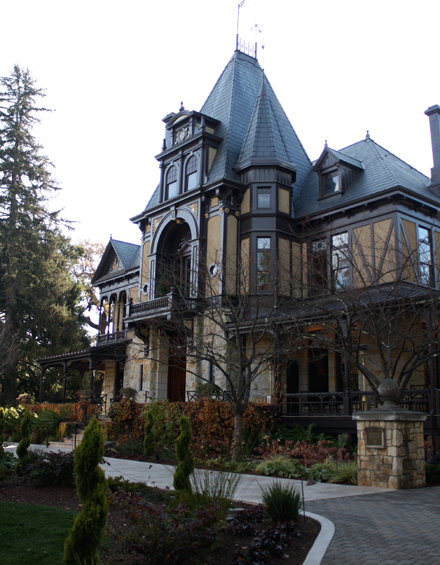
With Meat Boy the designated driver, Noodle Niece and I piled into the car on a sunny but chilly afternoon for the drive to Napa to visit Beringer Vineyards. Meat Boy’s good friend, who works for Beringer, had arranged for us to enjoy a private tour and tasting (normally $35 per person).
We thought Noodle Niece would find Beringer especially interesting, because it is the oldest continuously operating winery in the Napa Valley and is designated a Historic District on the National Register of Historic Places. Indeed, Beringer even continued to operate legally during Prohibition, according to our cordial guide, Michael. Apparently, a lot of doctors and priests were using Beringer wine back then for medicinal and religious purposes. Uh-huh.
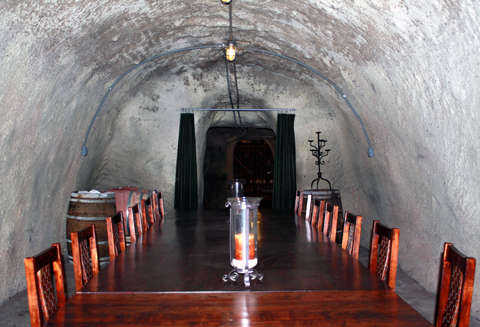
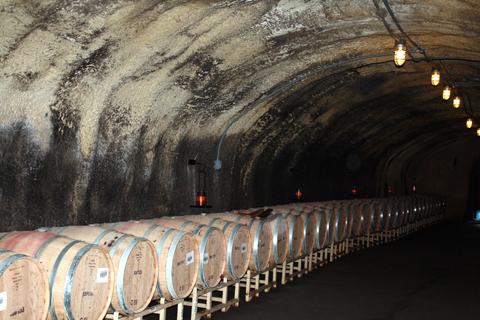
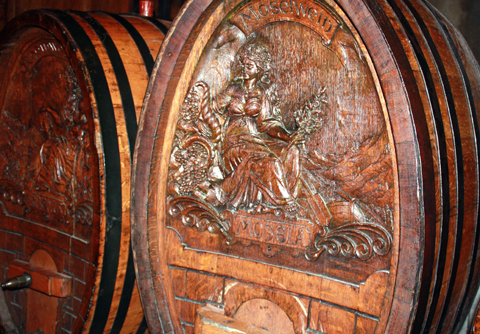
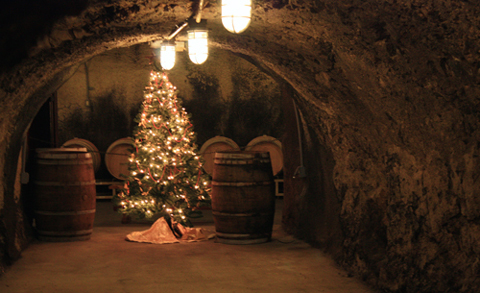
Established in 1876, Beringer also boasts an extraordinary 1,200 linear feet of aging caves that naturally help keep the wines at 58 to 60 degrees year-round with a humidity level of 75 to 80 percent. The caves were hand-chiseled by Chinese laborers who also built the Trans-Continental Railroad. Look closely, and you’ll see the actual pick marks.
The winery was started by brothers, Jacob and Frederick Beringer, immigrants from Germany who definitely knew how to do things with style.
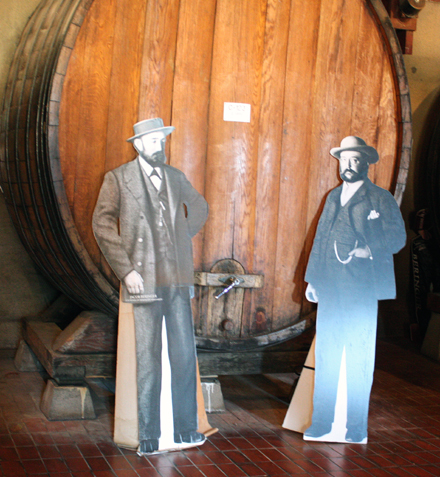
If you’ve ever driven Highway 29 to the winery, you’re no doubt familiar with the breathtaking stretch of road where towering elm trees form a near archway with their leafy canopies. We have younger brother, Jacob Beringer, to thank for that. It was his way of beautifying the road and of creating a marker so visitors would know exactly when they were nearing the winery. If you really want to be in-the-know, refer to it from now on as “Jacob’s tunnel of elms.”
Next, tour guide Michael led us into the impressive Rhine House. The 17-room mansion was completed in 1884 at a cost of $28,000, which was a lot of money in those days. It also was the first house in the Napa Valley to boast indoor plumbing.

Frederick Beringer wanted a house that evoked not only California, but his German roots. The result was this massive, ornate Victorian, decorated with 40 panels of stained glass that cost nearly a quarter of the house’s construction costs and are now considered priceless.
The stained glass is remarkable to behold. But the most intriguing fact about them is that they don’t look very majestic on the outside of the house. You have to step inside to behold them in their full glory. Michael explained that they were made this way specifically because they were designed for the pleasure of the people inside the house.

The stained glass designs also vary according to the use of the room. Flowers decorate the ones in the ladies’ sitting room. A portrait of a young William Shakespeare decorates the library’s window. The portrait is not drawn on the glass. Instead, soot was baked onto the glass, then carefully etched off with a pen to create the image. How astounding is that?
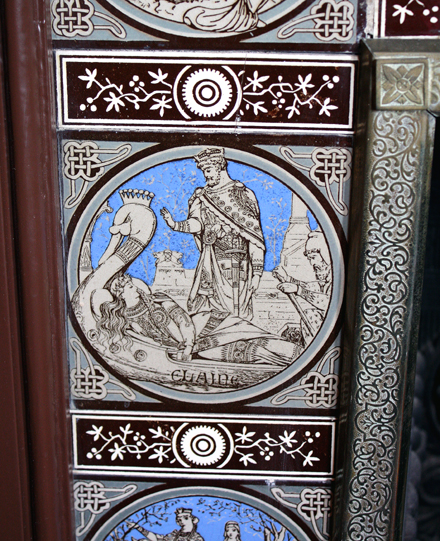
Michael invited us into what was once the “younger son’s room” to lead us through a tasting of Beringer wines.
We sat down at the large wood table, already set up with an array of empty wine glasses at each seat. As is customary, we tasted the lightest wines first, starting with the whites, then going into the reds, and finally ending with a dessert wine.
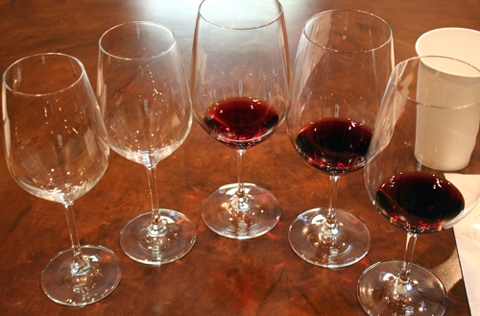
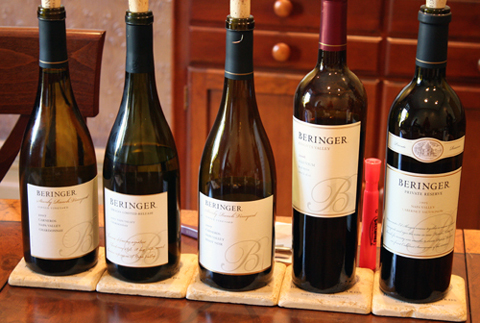
We each took the first wine glass in our hand, holding it by the stem. Then, we tilted the glass almost 90 degrees (don’t spill!). We studied the color of the outer rim of the wine in the glass. This gives an indication of the wine’s age. White wines turn darker as they age, while red wines turn brownish.
As Michael poured the first wine, a Leaning Oak Chardonnay, he told us to swirl the wine vigorously in the glass — or as he joked, “Do it at a party and tell people that you’re volatilizing the esters. They’ll be impressed!”
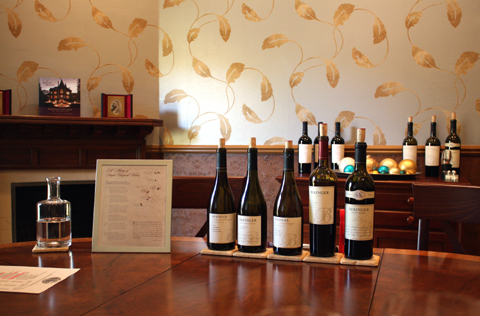
Next, he showed us how to use a finger to pinch each nostril closed while inhaling to determine which of our nostrils was the most clear. (And one is always clearer than the other, and which one it is may change during the course of the day, he said.) After swirling the wine, he instructed us to place our clearest nostril close to the rim of the glass to take a quick whiff to discern the aromas.
He also taught us what he calls the “three-sip method” of tasting. Take the first sip, roll it around in your mouth for five seconds before swallowing. Most likely, on the first sip, your taste buds will be assaulted with a bitter or sour taste, depending upon the wine varietal. Take a second sip, doing the same thing. You’ll notice that the wine will taste less harsh now Finally, take a third sip, and you will experience harmony in your mouth. In a way, the first two sips help coat your mouth to help prep your taste buds for the real taste of the wine.
Before the tasting, Noodle Niece admitted that she much preferred whites to reds, and especially liked sweet dessert wines. No surprise there. Most of us start out liking whites more because they’re easier to quaff than heavier reds full of astringent tannins. But as we grow more accustomed to wines, we learn to appreciate the fullness, brawn and heft that tannins lend.
Noodle Niece tasted two Chardonnays, a Pinot Noir, a Bourdeaux blend called Alluvium Red (which I adored for its cocoa notes), the 2005 Private Reserve Cabernet Sauvignon, and the 2006 Nightingale (made of Semillon and Sauvignon Blanc, it tastes of heavenly creme brulee and butterscotch).
She was surprised to discover that of the two Chardonnays, she preferred the reserve with its more buttery, toasty flavors as opposed to the younger Chardonnay with its clean, crisp profile. She was even more floored to learn that she really liked the Cab — yes, a red wine.
Noodle Niece ended up buying two bottles of the Nightingale dessert wine, which she plans to open for our family to enjoy after our Christmas dinner.
When I take a languid sip of that golden nectar, I know I’ll be thinking of our trip together to the winery. It’s a memory even sweeter than the wine, itself.
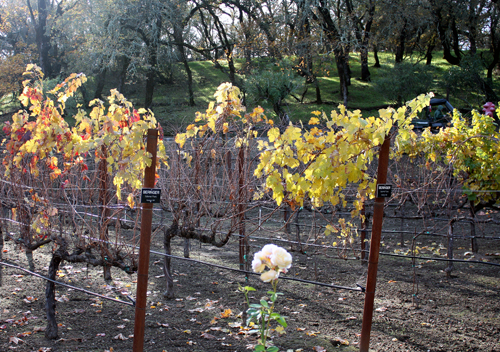

What a great read, and I always like taking visitors to Beringers for the tour – your photos and description are fantastic. What a fun afternoon – thanks for sharing the tip and I plan to try the three sip tasting this afternoon Sounds perfect.
Pingback: Food Gal » Blog Archive » A Taste of Beringer | The Bottle and Cork - Napa and Sonoma Wine blog
What a fun trip! I’ never been to Beringer but now have put it on my list. Wonderful post and photos! Happy holidays!
Pingback: Tweets that mention Food Gal » Blog Archive » A Taste of Beringer -- Topsy.com
Thanks for the visit! This house is fantastic.
Beringer wines are delicious!
cheers,
Rosa
thanks for the post. $35pp for a tour is out for me, but I enjoyed the writeup & pics! Merry Xmas.
Great post! One of the things I like about going to the Napa area is that there are the “big” wineries like that, and also the smaller boutique wineries, so there are a lot of different wine types and flavors to experience!
oh wow that place is GORGEOUS 😀
happy holidays!!
Whoa! That place is so…grand…majestic…stunning…yet a bit creepy too, in a delicious way!
Merry Christmas, Carolyn!!!
So cool! I love old houses! So many great details and so well built, unlike houses today that start falling apart the minute that they are finished.
What a magical place. I just love all your pictures, especially the stained glass windows.
Happy Holidays!
Beringer is fun and what a lovely day with your niece! I also love the tours at Benziger and Schramsberg.
Ha Ha volatilizing the esters..gotta use that one at my next dinner party!
Thanks for taking us on an amazing tour of Beringer Vineyards! I felt I was right there with you and Noodle Niece! 🙂 And it is indeed very special to introduce someone to wine… I hope you enjoyed the dessert wine! 🙂
This sounds like a lot of fun. My sister has been asking me to do a trip through the Napa Valley. We need to get serious and make real plans to do it.
Beautiful photos…wish I was there!